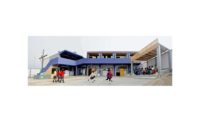Three Questions: Kate Stohr, Cofounder of Architecture for Humanity

Architects & Firms
Architectural Record: How did you get involved in humanitarian work?
Kate Stohr: I cofounded Architecture for Humanity with Cameron Sinclair in 1999. The spark that started the organization came after watching footage of refugees going back to Kosovo and finding their homes in rubble. You could easily imagine it was your own neighborhood.
It occurred to Cameron, who was an architect, that it would be interesting to think innovatively about how to build transitional shelter to temporarily house those returning to an environment that would undergo several years of reconstruction. We hosted a competition that was, as far as we know, the first online design competition—I was a web producer at the time—and that was the start. Today, Architecture for Humanity has 50 chapters in 25 countries and a network of more than 80,000 design professionals interested in building a more sustainable future.
We don’t provide emergency services or social services, as such. We focus on designing and building a more equitable built environment and helping communities—whether here at home or abroad—leverage design to achieve that end.
What’s the most pressing issue that architects and designers should be addressing?
We are concerned about the growing number of abandoned, decommissioned military sites around the world. There are thousands across Africa, Europe, and the Middle East. More than 200 bases were downsized or closed in the United States alone last year as part of the Base Realignment and Closure ruling. We all need to start thinking about innovative and sustainable redevelopment of these sites, which are often an economic and environmental drain on the communities that host them. Our current Open Architecture Challenge focuses on this problem. We’d love to see how people can think creatively about this issue.
What’s the most exciting thing you’ve seen in the past month?
You are asking the wrong person! Our design fellows spend a huge amount of time in the communities where we work and are probably a better source. I love so many projects, from a beautiful historic preservation project in Chile to a small project we did to re-imagine a side-street as a football pitch. Everyday is something new. That’s what makes the design field so much fun.




